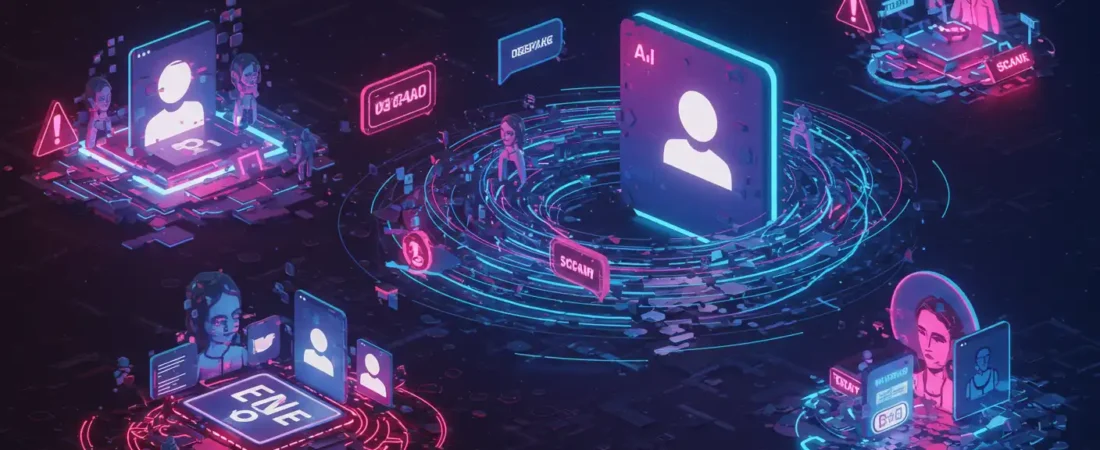Unveiling the Hidden Dangers of AI and Social Media
Social media has become one of the most powerful tools in modern society, shaping how we connect, share, and even form opinions. However, yet, with the rise of artificial intelligence, the risks tied to social media have grown exponentially. From AI social media risks to deepfake dangers and AI-generated scams, additionally, our digital world is at the center of a growing storm of misinformation and mistrust. In this article, we explore the hidden dangers of modern technology and AI, focusing on how they impact digital authenticity, create technology mistrust, and shape the future of online interactions.
Social Media Misinformation and AI Social Media Risks

Social media has become a global stage for information exchange, but it is equally a breeding ground for misinformation. Algorithms designed for engagement often amplify falsehoods, while AI tools make fake content more convincing. This convergence has created one of the most pressing digital challenges of our time.
How Algorithms Amplify False Narratives
At the heart of every platform lies an algorithm. These systems are built to maximize time spent online, not to safeguard accuracy. A landmark study from MIT researchers revealed that false information on Twitter spreads six times faster than the truth (source).
This amplification happens because algorithms prioritize sensational content. For instance, conspiracy theories, shocking images, or emotionally charged posts outperform fact-checked articles. As a result, misinformation is not an accident of social media it is a feature of its design.
Furthermore, the use of AI recommendation engines intensifies echo chambers. Users are shown more of what they already agree with, reinforcing biases and limiting exposure to alternative views. Consequently, misinformation does not just spread; it thrives.
The Role of AI in Accelerating Misinformation
The arrival of generative AI has supercharged misinformation. Moreover, tools like text generators and image creators allow malicious actors to craft fake news, phishing emails, and even realistic fake profiles at scale.
Previously, what once required sophisticated state actors can now be achieved by individuals with access to free AI tools. Consequently, this democratization of misinformation means anyone can create professional-looking propaganda, eroding the ability to distinguish truth from fabrication.
The Psychology of Belief in False Information
Humans are not passive victims of misinformation they are wired to fall for it. Three cognitive biases explain why:
- Confirmation Bias – We believe information aligned with our worldview.
- Illusory Truth Effect – Repetition increases believability.
- Social Proof – High engagement signals “credibility.”
Social media exploits all three. Algorithms ensure repetition, echo chambers confirm biases, and likes and shares act as social validation.
During the COVID-19 pandemic, anti-vaccine content surged across platforms, amplified by AI-driven bots. Despite factual corrections, many users continued to trust the misinformation more than verified medical sources.
Case Study – Election Manipulation
One of the most alarming AI social media risks lies in election interference. The 2016 U.S. election showed how trolls used bots to sow division. Today, deepfake dangers add a new dimension: videos of politicians saying things they never said circulate widely before being debunked.
Even when proven false, the damage lingers. Users are left with doubt, and trust in political processes weakens. This cycle of manipulation erodes democracy and fuels technology mistrust.
Social Media and AI Risks: Deepfake Dangers and Digital Authenticity Threats

Deepfakes are among the most alarming consequences of AI advancement. Moreover, they undermine the very concept of truth in the digital age, eroding trust and fueling the crisis of digital authenticity.
What Are Deepfakes?
Specifically, deepfakes are AI-generated videos or audio recordings that replicate real people’s likeness with uncanny accuracy. Powered by deep learning, these forgeries blur the line between reality and fabrication.
At first, deepfakes were novelties used in entertainment. But today, they pose serious ethical and security risks. They can impersonate leaders, celebrities, or even ordinary people for malicious purposes.
Real-World Consequences of Deepfakes
- Politics: Fake speeches destabilize nations. For example, a deepfake video of Ukrainian President Volodymyr Zelensky in 2022 urged soldiers to surrender quickly debunked, but dangerously effective.
- Corporate Fraud: Criminals clone CEOs’ voices to authorize money transfers.
- Personal Harassment: Non-consensual explicit content targets individuals, damaging reputations.
The Brookings Institution warns that “carefully made deepfakes can already be very realistic, though only under certain circumstances” (source).
The Crisis of Digital Trust
The phrase “seeing is believing” no longer applies. As deepfakes proliferate, the ability to trust digital media collapses. As a result, this fuels technology mistrust and digital authenticity threats, where people doubt even authentic sources.
The danger is twofold:
- Believing false content.
- Dismissing true content as fake.
Additionally, this phenomenon, known as the “liar’s dividend,” allows guilty individuals to claim incriminating real videos are fake, exploiting the deepfake crisis.
Tools for Detecting Deepfakes
Several solutions aim to fight back:
- AI-powered detectors to analyze media inconsistencies.
- Blockchain verification for authentic digital assets.
- Public education campaigns about digital literacy.
However, the race is ongoing. As detection improves, deepfake technology advances too.
Social Media AI-Generated Scams and the Rise of Phishing Emails

Scams are not new, but AI has made them more convincing than ever before. From AI-generated phishing emails to impersonation schemes, cybercriminals are leveraging technology to exploit trust at scale.
Smarter Scams Than Ever Before
Traditional phishing emails were often riddled with spelling errors. Today, AI creates flawless, personalized messages. In fact, these scams can mimic banks, employers, or even family members with frightening precision.
Moreover, artificial intelligence is increasingly being exploited by criminal networks to commit sophisticated fraud, create realistic deepfakes, and enhance phishing schemes, posing a growing threat to digital security and social trust.” – EU Serious and Organised Crime Threat Assessment (EU-SOCTA) 2025, Europol (source).
Social Media as a Gateway for Scams
Social media provides criminals with rich personal data. By analyzing posts, scammers craft targeted messages:
- Fake investments promising high returns.
- Impersonations of influencers or celebrities.
- Romance scams powered by AI chatbots simulating human affection.
Because these scams feel personal, victims are more likely to believe them.
How to Protect Yourself from AI-Generated Scams in Social Media
- Verify suspicious messages via official contacts.
- Enable two-factor authentication.
- Stay informed about common scams.
- Use AI-powered security tools that flag malicious communications.
The Future of Online Fraud
Fraudsters will continue to exploit AI innovations. Consequently, as deepfake voices and images improve, distinguishing scams from reality will become harder. This is why awareness and regulation are critical in fighting AI-generated scams.
Conclusion
Indeed, the dangers of social media and AI are no longer distant possibilities they are unfolding today. Moreover, from misinformation amplified by algorithms, to deepfake dangers undermining authenticity, to AI-generated scams exploiting trust, the digital world faces unprecedented challenges.
👉 Stay informed, stay safe.
Subscribe and join thousands of readers learning how to navigate the future of AI and technology with confidence.




